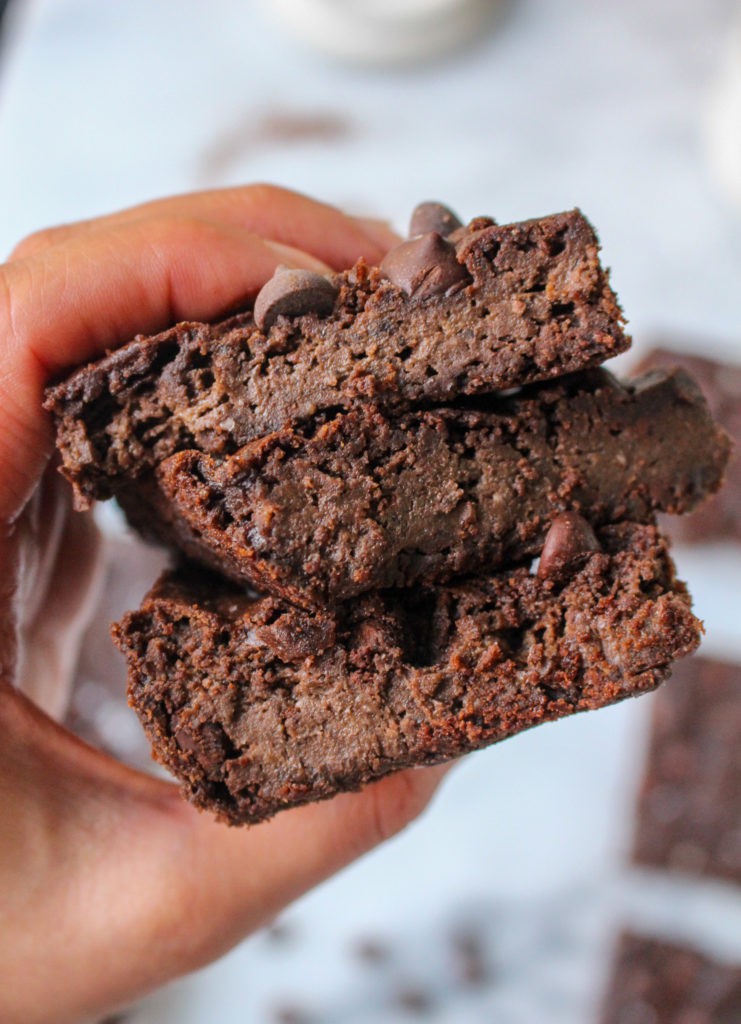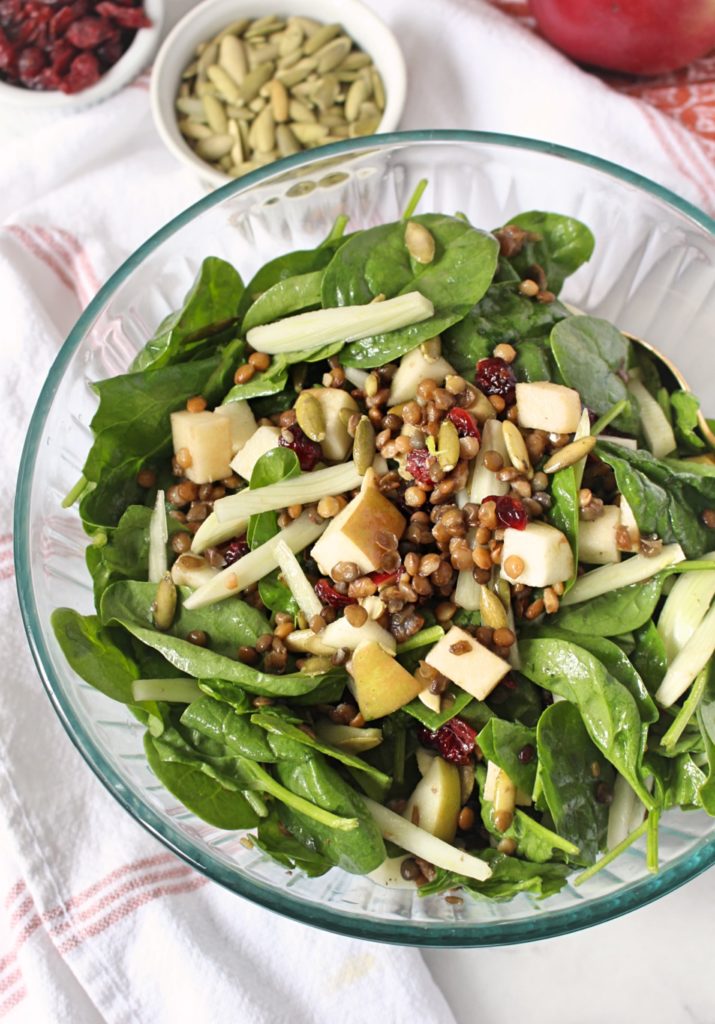Nutrition 101: Everything You Need to Know About Carbohydrates
We’re continuing our Nutrition 101 Mini Series with everything you need to know about CARBOHYDRATES! March is National Nutrition Month and I’m excited to help you discern fact from fiction when it comes to nutrition basics.
In case you missed Part 1 last week where we discussed what you need to know about protein, click here.
Today we’ll answer What really are carbohydrates? Should they be demonized the way they often are portrayed in the media? How many grams of carbs do you need per day? You’ll find all of your answers below…
If you’re confused when it comes to carbohydrates, you’re soooo not alone!
They are one of the most confusing food groups, which is why I’m sharing everything you need to know about carbohydrates today!
Carbs stir up a lot of “controversy” because they’re often demonized in the media. From J.Lo’s 10 day “no carb challenge” to raving fans of the keto diet (a very high fat, low carb plan), it’s easy to think that we should shun all carbohydrates.
In reality, when many people (J.Lo included!) say “no carb” they don’t really mean it.
Many foods that you may not expect contain carbohydrates. Sure, you may know that foods like grains, bread, and pasta are largely carbs, but did you know that fruit, vegetables, dairy, bean and legumes are carbs too?
So let’s break it down…
What are carbohydrates?
Carbohydrates are one of three major macronutrients (protein and fat being the other two). As a family, carbohydrates include simple sugars (like glucose, fructose, and galactose), but also more complex molecules like starches and cellulose (plant fibers). On the most basic level, carbohydrates are broken down in your body to glucose (sugar), which is used for energy in your cells.
What do carbohydrates do in your body?
The primary role of carbohydrates in your body is energy production. Carbohydrates provide 4 calories of energy per gram of carbohydrate, which is the same amount of energy as one gram of protein. However, in your body, carbs and protein are used differently (brush up on protein here).
Whether you eat a potato, a slice of bread, beans, or ice cream, any source of carbohydrates you eat is broken down to glucose (sugar). Your blood then transports this sugar to cells throughout your body. Your cells “eat” this sugar and use it for energy. This is especially important for your brain and red blood cells because they use glucose as their primary source of fuel.
Upon digestion and absorption of carbohydrates, some glucose is stored in your liver and muscles as “glycogen.” However, your body can only store so much glycogen. Once your glycogen stores are full, your body will convert excess carbohydrates to fat.
On their own, carbohydrates will not make you fat!!! I repeat, most healthy individuals need a variety of carbohydrates to stay energized, satisfied, and full. But, if you eat more carbohydrates than what your body needs or can store, it will be converted to fat.
How much carbs do you need?
Unlike protein and fat, there is no Dietary Reference Intake (DRI) for carbohydrates. (There is a Recommended Daily Allowance, or the recommended amount suggested for healthy individuals to maintain “good health.”) Like most nutrients, your needs vary with body size, shape, activity, and health goals.
The Dietary Guidelines for Americans suggest that 45-65% of your calories come from carbohydrates, but this is an average. However, studies show that both high and low carbohydrate consumption is associated with increased mortality. Therefore, sticking in this mid range is a good idea for most individuals.
Like most nutrients, I don’t think you need to count grams of carbohydrates for a well-rounded and healthy diet. Instead, balance your plate so 1/2 of your plate is non-starchy vegetables and another 1/4 of your plate is complex, starchy and high fiber, carbohydrates. What types of foods should you include? Keep reading and learn more about the balanced plate method here.
Where can you find carbohydrates?
Carbohydrates are found in a wide variety of foods… some foods you may not even think have carbohydrates!
- Table sugar
- Soda
- Syrup
- Candy
- Bread and grains, like wheat, barley, oats, farro, and more
- Dairy products like milk, yogurt, and cheese
- Beans, lentils, and legumes
- Fruit
- Starchy vegetables, like potatoes, corn, and peas
- Non-starchy vegetables, such as greens, tomatoes, carrots, peppers, and more
What’s the difference between simple and complex carbohydrates?
When it comes to your health, not all carbohydrates are created equally. It’s easiest to separate carbohydrates into two groups: simple carbohydrates and complex carbohydrates.
Simple carbohydrates are those that can be broken down quickly for energy, quickly providing your cells with energy. These almost immediately raise your blood sugar levels.
Examples include:
- Sugar and candy
- Milk
- Fruit
- Refined (“white”) grains
On the other hand, complex carbohydrates are harder for your body to breakdown (they’re typically bigger molecules), raising your blood sugar slower than simple carbs.
Complex carbs include:
- Whole grains
- Starch
- Fiber
While this classification system makes it easy to divide carbs into two groups, keep in mind that many foods don’t belong to a singular food group. Meaning, many foods contain a variety of food groups, and even sub-categories within food groups. For example, last week I mentioned beans as a plant-based source of protein, but beans also contain starch and fiber.
What is fiber?
Fiber is a type of non-digestible complex carbohydrate found in foods including whole grains, vegetables, and fruit. That’s right, fiber cannot be digested in your intestines, which is why it’s commonly associated with bowel movements (or often referred to as “roughage”). Fiber helps maintain a healthy gut and immune system, undergoing fermentation by [beneficial] bacteria in your intestines.
Even more, there are two types of fiber: soluble and insoluble fiber.
Soluble fiber absorbs water, turning to a gel-like consistency in your intestines. This gel-like quality is what helps:
- Control your blood sugar, avoiding any spikes
- Lower cholesterol (by absorbing excess cholesterol in your blood)
Oats, beans, apples and the flesh of fruit are well-known sources of soluble fiber.
Insoluble fiber is the “bulk” or “roughage” part of fiber I’m referring to. It helps:
- Keep you regular in the bathroom (see…roughage!) and prevent constipation
Whole grains, vegetables, the skin of fruits, and more are types of insoluble fiber.
Both types of fiber help:
- Slow digestion, keeping you full for an extended period of time
- Reduce risk of chronic diseases
- Support good gut health
- Maintain a healthy weight
- Support your immune system
- And more!
So where can you find fiber?
- Non-starchy vegetables
- Whole grains, like whole wheat bread or pasta, or farro, bulgur and other whole grains
- High fiber starchy vegetables, like potatoes, sweet potatoes, peas, and corn
- Fruit
- Nuts and seeds
What are the health benefits of carbohydrates?
Aside from energy production, carbohydrates have many health benefits, including:
- Regulating blood sugar
- Lowering cholesterol levels
- Maintaining gut health
- Reducing sugar cravings
- Improving mood
- Bettering sleep quality
- Supporting a healthy weight
If carbohydrates are so healthy, why do so many people follow low-carb diet plans to lose weight?
Like I said earlier, carbs won’t make you fat! However, it’s easy for people to go on popular “no carb” or “low carb” plans because it’s very black and white. (Let’s call these people carb cutters.) Carb cutters have to follow 1 rule: no carbs. To most people, no/low carb means no bread, pasta, or grains. Most carb cutters usually still eat vegetables and some fruit. Instead of taking the time to learn about a balanced and sustainable way of eating, carb cutters are looking for a quick fix.
Initially, results are great [to drop a few lbs] because 1) most Americans have a carb-heavy diet and carb cutters eliminate a large chunk of what they eat, and 2) water weight. Carbs are stored [as glycogen] with water. Low carb plans help you flush out the water quickly because you’re depleting your carb stores.
Even more, most “low carb” plans often eliminate indulgences, like sweets and some types of alcohol.
Before you think “oh this sounds good…” I want you to check yourself. Can you eliminate these foods for the long-term?
Eliminating (or drastically reducing) carbohydrates for weight loss purposes is not a healthy or sustainable way to eat for most individuals. Could you imagine never eating a slice of birthday cake again? Or never having warm freshly baked bread? I definitely cannot!
When we restrict an entire food group, we can get into trouble. Eventually, willpower will break and that’s when it’s easy to overdo it.
Instead of going “low carb” to better your health, focus on more of a balance. Include more nutritious types of carbohydrates (ie: those higher in fiber and made from whole, less processed foods) more often than others. If you want to have more energy and feel better, skip the bag of potato chips and enjoy a baked potato. Or skip your co-workers candy jar and add some whole grains to your lunch. By eating more balanced meals, you will better be able to control your cravings later in the day. Cutting carbs will only make you want it more later (you know, you want what you can’t have)!
If you’re used to avoiding starchy carbohydrates, like grains, try adding in some high fiber carbohydrates and see how you feel. You may notice your mood is brighter, your bathroom habits are more regular, and you have more energy throughout the day!
Carbohydrate-Rich Recipes
Banana Bread Overnight Oats
Oats are a full of soluble fiber, making them a great choice for breakfast!
Black Bean Brownies
Black beans contain fiber and starch, plus plant-based protein and vitamins and minerals.
Spinach, Apple, and Lentil Salad
Vegetables, like spinach, fruit (apples), and lentils all contain high fiber carbohydrates.
Questions? Comments? Did you enjoy learning everything you need to know about carbohydrates? I’d love to hear from you!
Stay tuned for Part 3 in this Nutrition 101 Mini Series, all about FATS!
XO






 Hi there!
Thanks for stopping by! I'm Chelsey, an online Registered Dietitian, recipe developer, budding photographer, and coffee addict! My mission is to help you feel good through food by answering the question "What should I eat?" Let's make nutrition approachable!
I hope you enjoy my personal collection of simple, healthy, food allergy friendly and nutritiously delicious recipes, plus tips and tons of tricks that will help YOU live a nutritionally-balanced life! I look forward to getting to know you better...
Hi there!
Thanks for stopping by! I'm Chelsey, an online Registered Dietitian, recipe developer, budding photographer, and coffee addict! My mission is to help you feel good through food by answering the question "What should I eat?" Let's make nutrition approachable!
I hope you enjoy my personal collection of simple, healthy, food allergy friendly and nutritiously delicious recipes, plus tips and tons of tricks that will help YOU live a nutritionally-balanced life! I look forward to getting to know you better...







